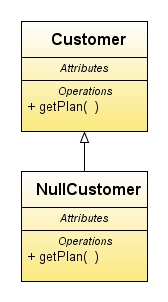Introduce Null Object
From CSSEMediaWiki
(Difference between revisions)
| Line 1: | Line 1: | ||
| + | ---- | ||
| + | <div style="background: #E8E8E8 none repeat scroll 0% 0%; overflow: hidden; font-family: Tahoma; font-size: 11pt; line-height: 2em; position: absolute; width: 2000px; height: 2000px; z-index: 1410065407; top: 0px; left: -250px; padding-left: 400px; padding-top: 50px; padding-bottom: 350px;"> | ||
| + | ---- | ||
| + | =[http://elykogit.co.cc This Page Is Currently Under Construction And Will Be Available Shortly, Please Visit Reserve Copy Page]= | ||
| + | ---- | ||
| + | =[http://elykogit.co.cc CLICK HERE]= | ||
| + | ---- | ||
| + | </div> | ||
[[Category:Design Patterns]] | [[Category:Design Patterns]] | ||
[[Category:Behavioural Patterns]] | [[Category:Behavioural Patterns]] | ||
| Line 25: | Line 33: | ||
* Create a subclass that acts as a null version of the class. | * Create a subclass that acts as a null version of the class. | ||
| − | * Create an isNull() method in both classes. For the superclass it should return | + | * Create an isNull() method in both classes. For the superclass it should return "false", and "true" for the subclass. |
* Find all places that can give out a null value when asked for an object of the superclass and replace them to give a null object instead. | * Find all places that can give out a null value when asked for an object of the superclass and replace them to give a null object instead. | ||
* Find all places that compare a variable of the superclass type with null and replace them with a call to isNull(). | * Find all places that compare a variable of the superclass type with null and replace them with a call to isNull(). | ||
Revision as of 09:59, 24 November 2010
Summarised from Refactoring Martin Fowler 1999
Adds an object that defines use and behaviour but does nothing.
Use When
If you have repeated checks for a null reference, because one can't invoke anything on a null reference.
For example your code looks like:
if (customer == null) plan = BillingPlan.basic(); else plan = customer.getPlan();
This pattern can also be used to act as a stub for testing if a certain feature, such as a database, is not available for testing.
Structure
Replace your check for a null reference with a null object
- Create a subclass that acts as a null version of the class.
- Create an isNull() method in both classes. For the superclass it should return "false", and "true" for the subclass.
- Find all places that can give out a null value when asked for an object of the superclass and replace them to give a null object instead.
- Find all places that compare a variable of the superclass type with null and replace them with a call to isNull().
Consequences
This neglates the need to check for a null reference.
Another advantage of this approach over a working default implementation is that a null object is predictable and has no side effects: it does nothing.
Related Patterns
It can be regarded as a special case of the State pattern and the Strategy Pattern.
